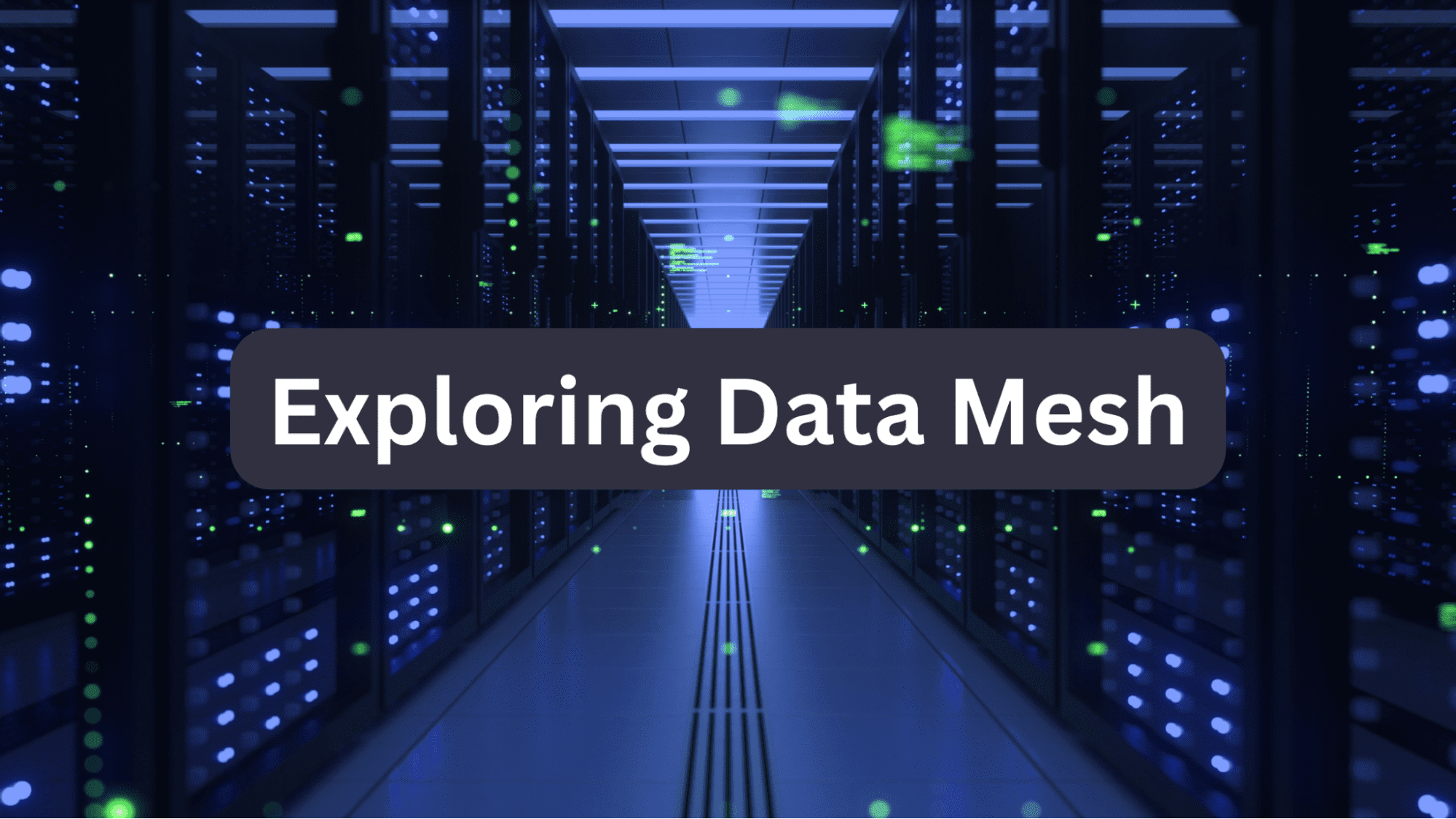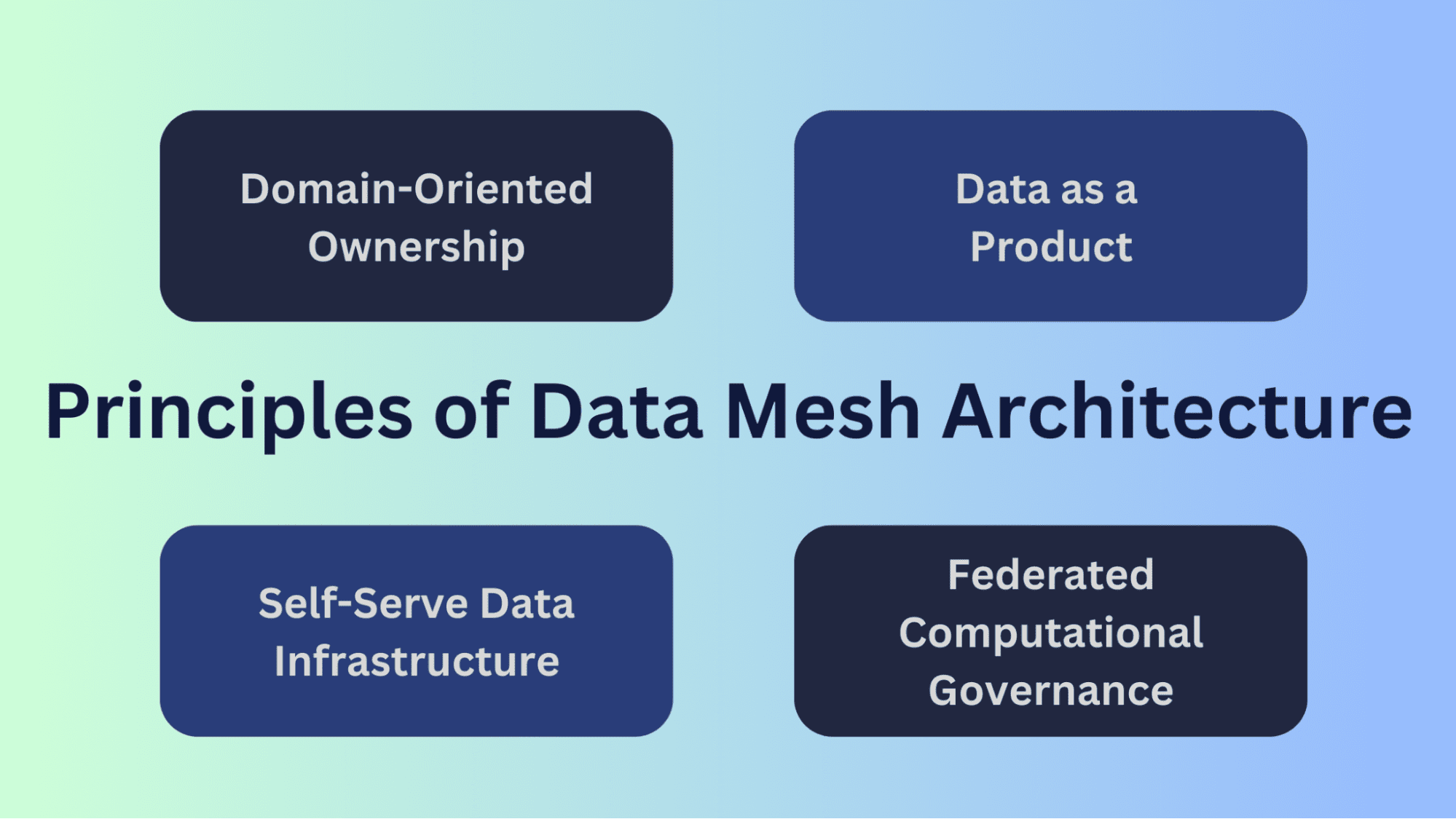Exploring Data Mesh: A Paradigm Shift in Data Architecture
Let’s explore Data Mesh, a modern approach to data architecture that decentralizes data ownership and management.

Image by Author
In response to changing technological, organizational, and business needs, data architecture has evolved over the last decade or so. But has this evolution been significant enough? Most organizations typically have a centralized data architecture. Which, by design, consolidates data under a single umbrella, often managed by a dedicated data team.
While effective in ensuring security and better governance, centralized data architecture has its limitations in terms of scalability, flexibility, and accessibility amongst others.
Enter Data Mesh, a concept (almost) analogous to microservices in software architecture. Data Mesh aims to decentralize data management just the way microservices focus on decentralizing application components. It distributes data ownership and accountability among domain-specific teams, acknowledging data as a strategic asset, best managed at its source.
In this article, we'll explore Data Mesh, its key principles, factors to consider, and challenges associated with the adoption of a data mesh architecture.
What Is a Data Mesh?
The concept of a Data Mesh was first introduced by Zhamak Dehghani, in the article "How to Move Beyond a Monolithic Data Lake to a Distributed Data Mesh" which outlines the principles and concepts behind the data mesh. This article and subsequent discussions within the data communities played a significant role in popularizing the data mesh architecture.
A Data Mesh is a contemporary approach to data architecture and management that departs from traditional centralized data models. It introduces a decentralized structure for organizing, distributing, and utilizing an organization's data assets.
In a data mesh, data ownership and responsibilities are distributed among domain-specific teams or data product teams, granting them autonomy in managing their data within their respective domains.
This decentralized approach aims to address the limitations associated with centralized data models, such as scalability challenges, data silos, and slow response times to changing data needs. By empowering domain-specific teams to independently manage their data, a data mesh promotes a culture of data autonomy, agility, and accountability within an organization. It also the efficient handling of diverse data sources while maintaining a focus on data quality and relevance.
Key Principles in the Data Mesh Architecture
Data Mesh architecture is built upon a set of principles designed to address the challenges of scaling and managing data within and across organizations. These principles provide a foundation for a decentralized and more scalable approach to data management.

Image by Author
Domain-Oriented Ownership
In a data mesh, data ownership is decentralized and distributed among various domains or business units within the organization. Each domain is responsible for the data generated and used within its specific area of expertise or functionality. This principle recognizes that domain experts are best equipped to understand and manage the data within their respective domains.
Domain-oriented ownership improves data quality and accuracy because those closest to the data source have a deep understanding of its context and can ensure its integrity. It also promotes a sense of ownership and responsibility for data, encouraging domain teams to maintain high data standards.
Data as a Product
Data in a data mesh is treated as a product rather than a byproduct of business operations. Each domain is responsible for delivering well-defined data products that are designed, packaged, and made available for consumption by other domains within the organization. These data products have clear definitions, access mechanisms, and service-level agreements (SLAs).
Treating data as a product encourages data producers to focus on delivering high-quality and valuable data to consumers. It also ensures that data products are designed with user needs in mind, making data more accessible and usable for a broader range of stakeholders.
Self-Serve Data Infrastructure
Data Mesh promotes the development of self-serve data infrastructure that empowers data consumers such as data analysts, data scientists, business users to access and process data independently. This infrastructure includes data catalogs, data discovery mechanisms, and data processing pipelines that enable consumers to find, understand, and utilize data without heavy reliance on centralized data engineering teams.
Self-serve data infrastructure reduces bottlenecks and accelerates data access empowering a broader range of users to work with data. It democratizes data within the organization, making it more accessible and enabling faster insights and decision-making.
Federated Computational Governance
To maintain data quality, security, and compliance in a decentralized data architecture, data mesh employs federated computational governance. Each domain defines and enforces its own governance policies tailored to the specific needs of its data. While there may be global standards and guidelines, individual domains have the autonomy to govern their data assets.
This balances the need for global data standards with the flexibility required by individual domains. It allows domains to adapt governance practices to their unique data challenges while ensuring that data remains secure, compliant, and of high quality.
These four key principles of data mesh, therefore, collectively aim to address the challenges of scaling data operations in large organizations by promoting:
- decentralization,
- data product thinking,
- self-service, and
- effective governance.
By implementing these principles, organizations can unlock the full potential of their data assets, improve collaboration between domain teams, and make data a more valuable and accessible resource for all stakeholders.
Implementing a Data Mesh? Here Are Factors to Consider
Transitioning to a data mesh often involves a significant cultural shift within an organization. A data mesh encourages collaboration, shared ownership, and data product thinking, aligning data practices more closely with the organization's evolving culture and values. Here are some factors that organizations might consider when implementing a data mesh.
Business Goals and Strategy
Any major shift in data architecture should align with the organization's broader business goals and strategic objectives.
Implementing a data mesh should be seen as a strategic enabler, enhancing the organization's ability to leverage data effectively to achieve its overall goals and objectives.
Existing Infrastructure
Organizations must evaluate and consider their current data infrastructure and investments when evaluating the feasibility of a data mesh.
Transitioning to a data mesh may require adjustments to the existing technology stack and infrastructure, making it essential to align these aspects with the new approach.
Data Complexity and Scale
When organizations face growing data complexity and scale, they must consider alternative data management approaches. A data mesh offers scalability and adaptability, especially when dealing with increasingly complex and large-scale data environments.
So a data mesh is a good choice when the volume, variety, or velocity of data makes it difficult to manage centrally, or when data requirements are diverse across different business units or domains.
Data Governance and Compliance
Maintaining data quality, privacy, security, and compliance is a challenging aspect of data management, particularly in decentralized environments.
A data mesh strategy must address these complexities effectively, ensuring data governance practices and regulatory requirements are met.
Data Accessibility and Ownership
In organizations with distributed data sources and diverse domains, traditional centralized data management may not suffice. Implementing a data mesh aligns data ownership with domain-specific teams, empowering them to take responsibility for their data, which can be particularly valuable in such environments.
Also, to facilitate data-driven decision-making throughout the organization, it's crucial to make data more accessible. A data mesh democratizes data access, allowing a wider range of users to access and utilize data, leading to improved decision-making across various departments or teams.
Challenges in Adopting a Data Mesh Architecture
Moving from a centralized data architecture to a data mesh is not without challenges. In this section, we delve into some of them—from governance to monitoring.
Data Governance
In a data mesh, data governance becomes more complex because data is distributed across multiple domains and teams. Ensuring consistent data quality, privacy, security, and compliance standards across these domains can be challenging:
- Establishing clear data ownership and responsibility for data governance tasks, such as defining data schemas and access controls, can be a challenge when multiple teams are involved.
- Developing and enforcing data governance policies and practices that align with the decentralized nature of a data mesh requires careful planning.
Data Discoverability
In a decentralized data mesh, discovering and accessing data can be challenging. Ensuring that data is properly cataloged, tagged, and documented is essential for enabling data discoverability. Here are some strategies:
- Implementing effective metadata management practices to provide context and descriptions for datasets, making it easier for users to understand the available data resources.
- Developing and maintaining a data catalog or metadata repository that allows users to search for and find relevant datasets efficiently.
Data Ownership
A clear and consistent definition of data ownership and accountability for each data domain and data product is crucial in a data mesh. Determining who is responsible for maintaining, updating, and curating the data can be challenging, especially when there are multiple stakeholders. Organizations can address this challenge by:
- Ensuring that data owners have the necessary authority and resources to manage their data domains effectively.
- Establishing mechanisms for resolving conflicts or disputes related to data ownership and responsibilities.
Monitoring and Observability
In a data mesh, monitoring the health, performance, and reliability of data pipelines and data products can be complex. Some strategies include:
- Implementing robust monitoring and observability tools and practices to track data quality, latency, and usage across different domains.
- Developing alerting and reporting mechanisms to quickly identify and address issues that may affect data availability or reliability.
We’ve highlighted some challenges in the implementation of a data mesh. These are more of checkpoints that organizations should be aware of when moving to a decentralized data mesh architecture.
Conclusion
Data Mesh, therefore, is a paradigm shift in data architecture, offering solutions to the challenges of centralized models. We discussed how distributing data ownership, promoting data product thinking, and enabling self-service access are beneficial. However, successful implementation requires careful consideration of cultural and technological factors, and a proactive approach to data governance.
Bala Priya C is a developer and technical writer from India. She likes working at the intersection of math, programming, data science, and content creation. Her areas of interest and expertise include DevOps, data science, and natural language processing. She enjoys reading, writing, coding, and coffee! Currently, she's working on learning and sharing her knowledge with the developer community by authoring tutorials, how-to guides, opinion pieces, and more. Bala also creates engaging resource overviews and coding tutorials.
